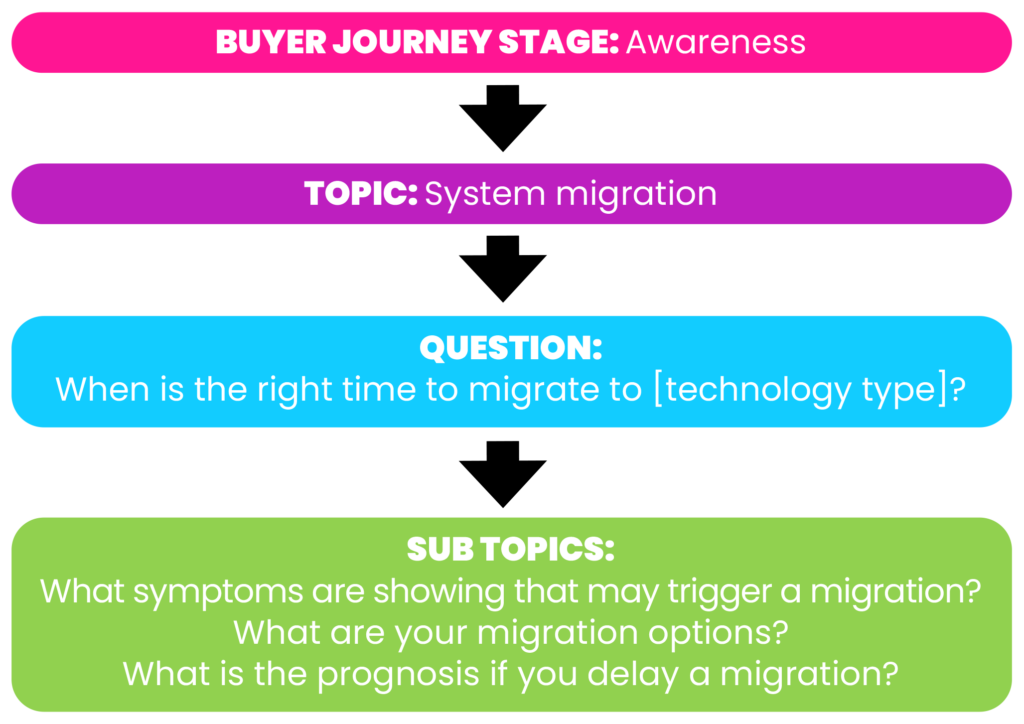
How we mastered a customer-centric content strategy with a Brilliant Ideas Bank

David Ruane
Our guest author, Dave Ruane, is Global Director Client Solutions at Lion People Global a growth solutions company, and former director of Marketing at XTM International. He shares his example of how their B2B business implemented a customer-centric content strategy and the pivotal role of the Brilliant Ideas Bank.
What is a customer-centric content strategy?
A customer-centric approach aims to anticipate customer needs, secure interest with prospects and clients, and win their trust by showing that you know their pain-points and how to help them. The appeal of a customer-centric content strategy is that it helps businesses speak to customers in a way that resonates with them at different stages of their customer journey. Consequently, customer centricity is strongly correlated with revenue growth.
How we created content for our customer journeys
Having mapped our customer journeys, it still felt like creating customer-centric content was an enigma. The key to mastery lies not just in understanding the path but in illuminating it for our customers at every turn. This is where the innovative concept of the Brilliant Ideas Bank – a strategic methodology designed by Lorraine Emmett at EC-PR – began to transform our content creation process and align it seamlessly with our customer’s journey.
Understanding the Brilliant Ideas Bank (BIB)
At its core, the Brilliant Ideas Bank is a strategic repository overflowing with ideas directly connected to each phase of your customer’s journey. It goes beyond being just a collection of blog titles or campaign ideas; it’s a fully fleshed-out roadmap tailored to each persona you cater to, ensuring every piece of content serves a strategic purpose.
Why the Brilliant Ideas Bank was a eureka moment for me
“They say that when we progress on a learning journey (in any discipline) we move from a state of ignorance to one of unconscious competence. At that point, the skill or behaviour has become second nature, and we are able to perform it without any conscious effort. This is also referred to as mastery, although many will recognise even then, that there is always room for improvement and growth.”
The first time I managed the delivery of a comprehensive communications strategy, I initially struggled to understand where we were going and how we would achieve “mastery.” It was when we adopted the BIB methodology from EC-PR, that the light started to dawn. Why? Because it solved an ongoing dilemma we were struggling with – what content to write next. More importantly, how do we ensure that the content resonates with every persona and addresses the stage they are at in their unique customer journey?
We were working quite well as a team when it came to focused campaigns, however we were missing our high-level roadmap which explained the purpose of each piece of content for each persona and their buyer stage.
Build your own Brilliant Ideas Bank: a step-by-step guide to create customer-centric content
Before we could create our roadmap, we had some groundwork to do.
Foundational work
First, we needed a communication strategy. For this, collaboration is key. We worked with a cross functional team to develop our strategy. The steps looked something like this:
1 Corporate level ideation: We began with senior managers and content strategists defining our value proposition, target sectors, and customer personas. We initially built 4 personas, which were representative of our customers.
Communications working groups: We then expanded the groups to incorporate sales and marketing. Exploring each persona in detail, we developed in-depth profiles, including their likes, dislikes, ambitions/aspirations, values, and pain points. For instance, “Connected Christine”, a technical manager, highlighted the need for content that addresses manual processes leading to increased costs and time wastage.
Ideation and mapping: Once our personas were defined, we could work on our value proposition and tailored messaging for each persona throughout their customer journey.

For example, for Connected Christine, our high-level engagement message would be:
Dear Connected Christine, an enterprise {magic system or technology type we provide} is NOW an essential part of the content technology stack in the Cloud to ensure you can efficiently {do something valuable} with your website and its content. How are you ensuring you have {some specific hook question of relevance}?”


This structured approach not only made content creation more straightforward but also ensured each piece was strategically placed within our larger content ecosystem. This is where things started to make visual sense.
An example of customer-centric content planning
Once we had our roadmap in place, we could focus on refining the topics, adding specific details, prioritising and we could start to build a content creation schedule and marketing calendar.
Choosing the right format
Once you have your roadmap, you need to decide how you will deliver it. Decide on the format of each topic; should it be a blog, social post, infographic, webinar topic, quick expert conversation on video etc.? Invariably each piece would have a static asset and then be linked from dynamic content. We found that short-form insights were more effective during the engagement stage (social posts, infographics, blogs, videos). And as interest in our products and services increased, webinars and longer form deeper dive information became more impactful.
Top tip> Evolving and leveling up content:
We had a content product series which answered typical buyer questions, they were short form in text (up to 500 words). Through our data, we identified popular short-form content that could be turned into detailed industry reports and articles for publication in industry magazines. And don’t forget to repurpose your longer-form content into short-form bitesize content, it works both ways. Always be open to feedback – your personas may change over time; you can always improve on what’s been done before – so continuously level up your content.
What we gained from implementing our customer-centric content strategy
There are many gains from implementing the Brilliant Ideas Bank including:
- Our content is laser focused and purposeful, it generates demand for our services,
- Brainstorming in this way eliminates redundancy, your content is all connected back to your personas and company’s value proposition,
- The content forms a logical flow, one topic leads to the next, what I refer to as breadcrumbing,
- You feel you are making solid progress e.g. this month we know that we will create: 2 engagement pieces, 1 reinforcement piece, 2 solutions pieces and 3 value pieces for Connected Christine.
Team productivity and motivation increased significantly as we had a clear roadmap and could all play our part in delivery. Also important here was that the blocks were easily achievable, which gave the team a great feeling of control.
What I learned about mastering customer-centric content
- Don’t skip steps: Especially the first time developing a content strategy and BIB.
- Alignment: You need close alignment between the value proposition and messaging for each persona and the calendar of topics.
- Guidance from experts: Having experts guide us on this journey was helpful. I could see that without a guide, we could have been blocked between the persona building and BIB creation stages. Passing the torch really must be done well.
- Continuous improvement: Mostly though, we found this process was logical with its fair share of eureka moments, the learning happens during the process which we felt was also by design and was needed to build team alignment.
I´d recommend trying the EC-PR Brilliant Ideas Bank methodology either as part of a full communications strategy or in a narrower sense, for example as part of a marketing content campaign. I found it a key tool to have as a content marketer and it was instrumental in building content that resonated, first time. Customer-centric content mastery is a continuous journey for most, this is one roadmap you will want to bring with you.”
Read more about the XTM International case study here.

Discover what six senior leaders who have embraced social and learned from their experience – watch our webinar and grab our exclusive report “Leaders on LinkedIn”
How to become a thought leader
BEACON B2B PR Guide
Essential advice and tactics on how to do B2B Tech PR thought leadership.


